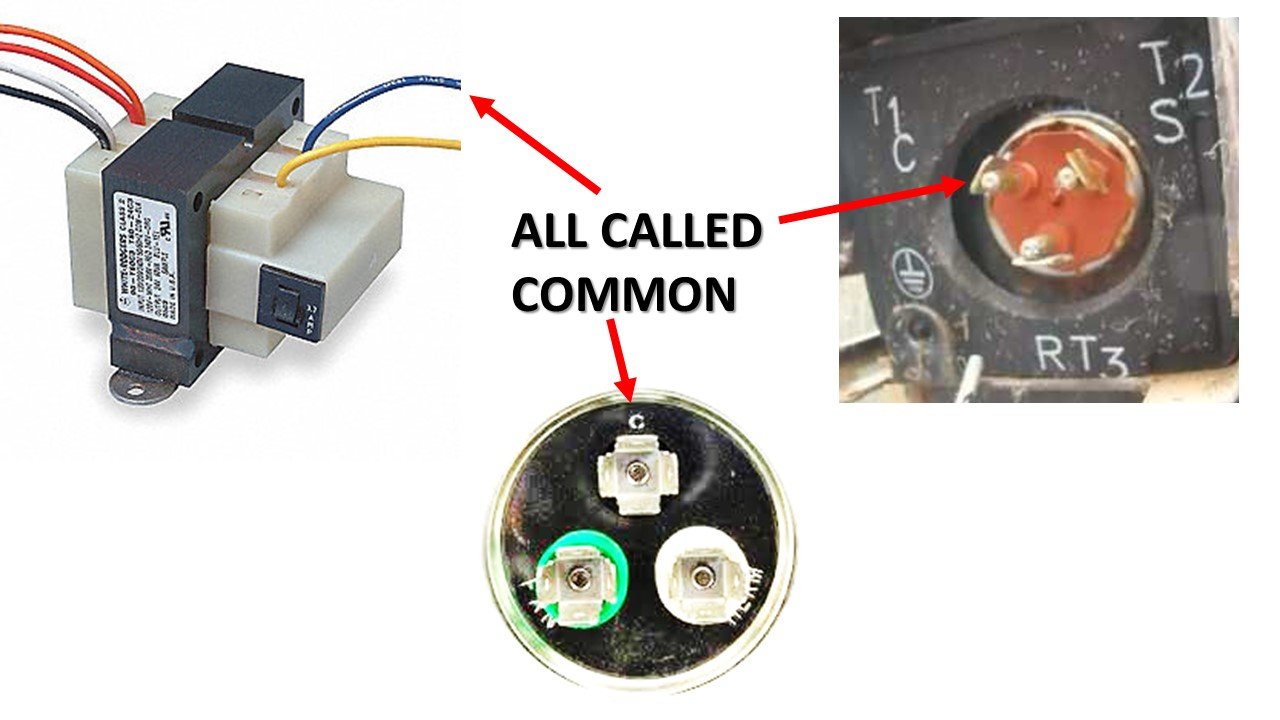Get Tech Tips
Subscribe to free tech tips.
C stands for “Common Mistake”

You have seen the C terminal on a dual run capacitor before. You have also seen the C terminal on a compressor.
It stands to reason that they would both connect together, right?
They don't connect, and they aren't even related, at least not in the way you think.
In both cases, the C denotes a “common point” in the dual capacitor. It is the common point between the fan capacitor (fan) and the compressor capacitor (herm).
In the compressor, it is the common point between the run and start windings (this is why R+C + S+C = R+S if you ohm a compressor).

The C terminal of a dual capacitor is actually fed from the OPPOSITE leg of power as the C terminal on the compressor. That is because you must power the start and run windings with the same leg and common with the other leg.
A way to remember it is by memorizing:
“The same leg that feeds start feeds run”
The C terminal on a capacitor is actually the common feed for the start winding of the compressor and fan (OPPOSITE side from the fan and herm plates on the capacitor).
So, here are the compressor terminals:
- C goes to one leg of power.
- R goes to the other.
- S goes to the HERM terminal on a capacitor, with the other side of that capacitor (C) going to the same leg that feeds R.

C what I'm saying? Confusing.
With 208v or 240v circuits, the L1 and L2 high voltage incoming lines make no difference as to which one is which when you connect. You could swap them on the L1 and L2 on the contactor, and it wouldn't change anything. But once we decide which is connected to Run and which is connected to common on the COMPRESSOR, we need to hook the run side to capacitor C, not the compressor common side.

There is also ANOTHER common “common” we see, and that is the secondary side of a low voltage transformer that is opposite from R or hot. You may notice that many low-voltage transformers have an ungrounded secondary, meaning that either of the wires in the secondary could be hot or common, depending on how you hook it up.
In other words, one side of the transformer is designated HOT because we connect it to the line side of our control switches (thermostats, defrost boards, safety circuits), and common is the common point where all the loads connect on the opposite side of the circuit from the line.
If you are new to the trade and see the designation C or the word common, don't assume it is the same as other C and common terminals and start connecting stuff together… Unless you like creating smoke.
—Bryan










Comments
Great article! Caps can confuse me sometimes; much clearer understanding now
Great article! Caps can confuse me sometimes; much clearer understanding now
As I site possessor I believe the content matter here is rattling wonderful , appreciate it for your efforts. You should keep it up forever! Best of luck.
As I site possessor I believe the content matter here is rattling wonderful , appreciate it for your efforts. You should keep it up forever! Best of luck.
I do not even know how I ended up here, but I thought this post was good. I don’t know who you are but certainly you’re going to a famous blogger if you are not already 😉 Cheers!
I do not even know how I ended up here, but I thought this post was good. I don’t know who you are but certainly you’re going to a famous blogger if you are not already 😉 Cheers!
OR L1 FROM BOTTOM ON CONTACTOR GOES TO TO COMMON OF COMPRESSOR AND FAN
L2 FROM CONTACTOR GOES TO BOTH RUNS ( COMPRESSOR AND FAN)
L2 FROM CONTACTOR GOES TO COMMON ON DUAL CAPACITOR
HERM ON CAPACITOR GOES TO START OF COMPRESSOR
FAN ON CAPACITOR GOES TO START ON FAN
I hope this is a easier way just follow schematic commonly ( red and black wires)
OR L1 FROM BOTTOM ON CONTACTOR GOES TO TO COMMON OF COMPRESSOR AND FAN
L2 FROM CONTACTOR GOES TO BOTH RUNS ( COMPRESSOR AND FAN)
L2 FROM CONTACTOR GOES TO COMMON ON DUAL CAPACITOR
HERM ON CAPACITOR GOES TO START OF COMPRESSOR
FAN ON CAPACITOR GOES TO START ON FAN
I hope this is a easier way just follow schematic commonly ( red and black wires)
I always like the challenge of putting the smoke back in!
I always like the challenge of putting the smoke back in!
Does it matter if you connect the common on the cap to the shunt side or the contactor side of the contactor
Does it matter if you connect the common on the cap to the shunt side or the contactor side of the contactor
To leave a comment, you need to log in.
Log In